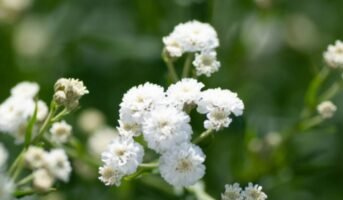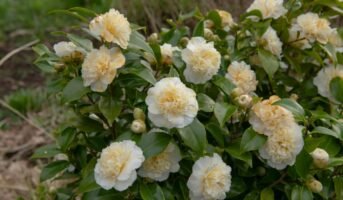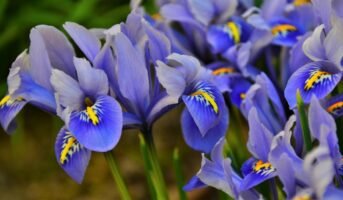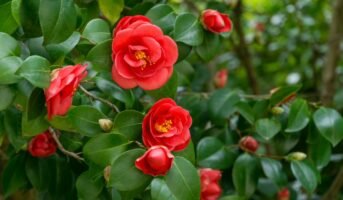There are nearly nine species of Plumerias that originated in Mexico and Central America. The popular Plumeria species are Plumeria rubra, Plumeria obtusa, Plumeria pudica and Plumeria alba. Many cultivated varieties have been developed and hundreds of flower colours can be seen worldwide. The most common colour combinations for plumeria flowers are cream and yellow, yellow and pink, and pink and red. The fragrance of the Plumeria flowers is diverse, ranging from coconut to jasmine, including citrus and rose. A few species and hybrids are grown as ornamentals in tropical and subtropical areas.

See also: What makes the sweet-smelling Frangipani a must-have garden plant?
Plumeria Pudica – Key facts
| Botanical Name: Plumeria pudica Jacq.
Common Name: Wild Plumeria, Bridal Bouquet, White Frangipani, Lei flower and Fiddle Leaf Plumeria Plant Family: Apocynaceae Genus: Plumeria Plant Form: Shrub Leaves: Dark green with unusual fiddle-shaped or spoon-shaped leaves Flowers: White with a yellow centre Flowering time: Almost throughout the year Light conditions: Full sun to partial shade Type of soil: Well-drained soil Soil pH: 5.5-6.0 Origin: Columbia and Venezuela Height: Reaches up to 4-8 feet Significance: Generally cultivated in gardens as an ornamental plant |
Types of Plumeria Pudica
Plumeria obtuse, better known as ‘Singapore White’, has white-yellow flowers with rounded petals. The plants tend to be smaller than the other types. All the species have different leaf shapes. Depending on the type and method of planting it can be a small tree or a decorative shrub in the garden.
Red frangipani, Plumeria Rubra, is available in numerous varieties. The flowers come in various shapes and colours due to selective breeding and natural cross-pollination with other Plumeria species. Mostly they are pinwheel-shaped with five overlapping petals. Red frangipani is cultivated as a flowering ornamental tree.
Plumeria ‘Candy Stripe’ is a hybrid with broad leaves and eye-catching blooms. The fragrant petals are curved inward from the sides and flaunt a lovely combination of white, yellow, and deep pink radial stripes.
Plumeria alba or white frangipani has white flowers with a yellow centre without any tinge of red on the buds or flower stalks. The flowers are large funnel-shaped, white and yellow in the middle, with an amazing fragrance.
Plumeria stenophylla has thin, white flower petals, with gaps between each petal, and long, thin leaves. It has white flowers and five narrow pinwheel-like petals. Plumeria stenophylla is a well-shaped, bushy shrub with a long-lasting flower display.
Plumeria Stenopetala is a hybrid, compact plant, with deciduous, long and narrow leaves and white flowers with narrow petals. The flowers are fragrant at night. Plumeria stenopetala is one of the most fragrant options available.


Read also: All about Cosmos bipinnatus
Plumeria Pudica care
Here are some basic tips to remember when growing Plumeria pudica.
Sunlight
Plumeria Pudica prefers bright sunlight and moderate humidity. For maximum growth, they need at least 5 to 6 hours of direct sun every day. If growing indoors, choose a very sunny location.
Watering
Keep the soil moist during summers but water sparingly during winters. Water your plumeria pudica twice a week during the summer. However, be careful about overwatering because it can lead to rot and kill the plant.
Soil
Plumeria pudica prefers slightly acidic and easy-draining soil to avoid waterlogging. Add compost to the soil before planting. Heavy soils must be added with sand, horticultural grit, perlite or peat moss to improve water flow. The roots become highly susceptible to rot when planted in clay soil that absorbs too much water. Fertilize frequently during the growing season with high phosphorus (blossom-booster) fertilizer to encourage flowering.
Pruning
Prune the plumeria pudica a few inches above the joint of two branches. Pruning regularly promotes growth by branching and, hence, leads to more flowers. Prune it bit by bit once a bunch of flowering is over and the flowers dry out. Prune dead branches or twigs, which would promote more growth and flowering.
Protection from diseases and pests
Plumeria pudica or frangipani plants are robust and do not have diseases or pest infestations.
Root rot is the result of poor drainage and waterlogging. To save the plant, repot the Plumeria, add a drainage layer and reduce watering. Drain out excess water from the plant saucer.
If a Plumeria pudica plant has been infested by spider mites, wipe them off with a damp cloth and spray the plant regularly with water to increase humidity.
Scale insects, that have brown shells, secrete a sticky honeydew that sticks to the leaves and is a sign of infestation. Wash the scale insects off immediately.
Woolly aphids secrete honeydew and should be wiped off. Both scale bugs and woolly aphids can be treated with neem oil.
Plumeria Pudica propagation
Plumeria pudica is easy to propagate from cuttings. Take a cutting from a healthy, mature plumeria pudica. Cut a stem tip, 14 to 18 inches long, at an oblique angle to the limb. Mature Plumeria stems that have a little grey bark may root easily and quickly reach a blooming size. Being a milky sap plant, it can be a skin irritant for some people so be careful while cutting. Dry the cutting for 3-4 days to form a callous at the cut end and then put it into the soil. Water sparingly but keep the soil moist. Place the newly planted cutting in full sunlight.

Plumeria flowers – Symbolic meaning
The plumeria flower symbolises birth, love and new beginnings. In Hawaiian culture, the plumeria reveals a woman’s romantic status when worn in the hair. In Asia, the frangipani plant symbolises immortality and is often grown in temples, hence, it is also known as the temple tree. In Hindu culture, it represents devotion. White plumeria pudica symbolises spirituality and devotion, hence, it is mostly used in wedding ceremonies (garlands and bridal bouquets) and baptisms. In Buddhism, this flower is a symbol of immortality as it can produce new blooms even after it is uprooted.


FAQs
Is Plumeria Pudica fast-growing?
Plumeria pudica is a fast-growing, evergreen frangipani. It has deep green foliage and iridescent white flowers. It flowers throughout spring and summer.
Is plumeria pudica fragrant?
The showy flowers of the Plumeria Pudica are usually white with a bright yellow centre. This particular species is often unscented, although some species of a light pink variety possess a mild fragrance.
Can plumeria pudica grow in pots?
Plumeria pudica plants can be grown in pots as long as they receive at least six hours of sun each day. Indoor plumerias grow best in a bright, sunny room or front of a big window. Choose a large pot with drainage holes at the bottom and place it on a portable pot stand.
What are the uses of Plumeria?
The Plumeria is mainly used as a source of perfume and oil and for decorating houses and temples. However, some researchers use plumeria as a potential treatment for cancer and Alzheimer’s disease. The plumeria’s root bark is used in the treatment of blennorrhagia, herpes and syphilis and the latex from the stem is used for treating ulcers and skin diseases. It is often used in the natural health industry to soothe dry, cracked skin. In Ayurveda, the oil of plumeria is considered a warming oil and effective in soothing fear, anxiety and insomnia.
Purnima Goswami Sharma is a freelance writer based in Mumbai, who has been contributing to various newspapers, magazines and portals for the last two decades. Besides being a research writer for various TV shows, she has been a visiting faculty at SNDT for Communication Skills. She hold a master’s degree in English Literature from Mumbai University and a diploma in Communications and Journalism. She writes on diverse subjects like real estate, interiors, education, lifestyle, health, entertainment and environment.
Email: [email protected]












